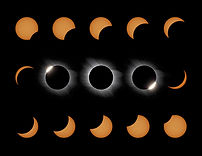All reports
April 2016 - Tiny, but Mighty
Report #14 - March 2016
An Erie Shadow
Solar eclipses are just as jaw-dropping as lunar eclipses. There's more than just that lovely sight of the Moon overlapping the Sun from the sky, It is only twice a year that the Moon's shadow blinds our planet with darkness during a solar eclipse...
...but then there are days in which we can never see the Moon; a new Moon. During this time, the Moon travels between the Sun and Earth, but at a slight angle just so that the Moon isn't silhouetted by the glowing sun, making it invisible to us from the sky.

An image of a full solar eclipse.

An artist's impression of what a new Moon would look like if it were visible.
The Moon is not to be overlooked, but it's within the events of a solar eclipse that the Moon really reminds us how precious it really is.
From Below
During a solar eclipse, we witness the Moon closing in on the Sun, traveling to overlap the Sun's disk. That is, until a full solar eclipse occurs and the Sun, Moon, and Earth are in complete alignment with one another. Such a view may be blinding to our eyes, but nothing compares to the Moon's narrow shadow that decks only 1% of the Earth's surface in darkness, changing daytime into nighttime for only a mere couple of minutes; a wake-up call to what the Moon can really do.

The phases of a solar eclipse.

An artist's impression of a full solar eclipse.

An image taken when the Moon's shadow covered a small part of Earth (during a full solar eclipse).
From Above
However, from space, a different view can be seen of the solar eclipse. Standing aside the Earth in space, one would be able to witness a cascade of black shadow fall over the top of Earth's atmosphere, dimming section of our planet's sky, hence why citizens experience a sudden "black-out" from the Sun's light during a solar eclipse. When the Moon completely overlaps the sun's disk, the moon's shadow, dressed upon Earth, can stretch to a wide 100 miles!


The Moon's shadow over the Indian Ocean during a 2002 solar eclipse.
The Moon's shadow over the Pacific Ocean during a 2012 solar eclipse.

The shadow of the Moon gliding over the Mediterranean Sea during a full solar eclipse in 2006.
SOURCES:
NASA's Goddard Space Flight Center
Cover image courtesy of NASA/SVS/LRO/E. Wright
Video and images courtesy of NASA/JSC
http://svs.gsfc.nasa.gov/cgi-bin/details.cgi?aid=11842
http://www.timeanddate.com/eclipse/total-solar-eclipse.html
http://earthsky.org/moon-phases/new-moon
http://www.nikonusa.com/en/Learn-And-Explore/Article/h20zakgu/How-to-Photograph-a-Solar-Eclipse.html
https://bpsfuelforthought.wordpress.com/2015/03/20/solar-eclipse/